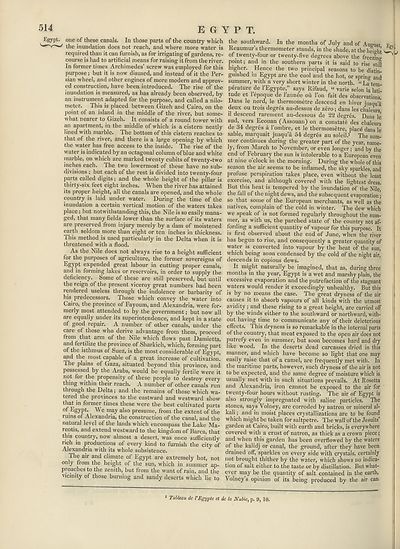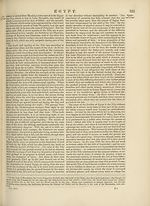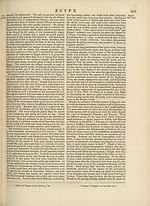Encyclopaedia Britannica > Volume 8, DIA-England
(524) Page 514
Download files
Complete book:
Individual page:
Thumbnail gallery: Grid view | List view

514
EGYPT.
Egypt, one of these canals. In those parts of the country which
the inundation does not reach, and where more water is
required than it can furnish, as for irrigating of gardens, re¬
course is had to artificial means for raising it from the river.
In former times Archimedes’ screw was employed for this
purpose; but it is now disused, and instead of it the Per¬
sian wheel, and other engines of more modern and approv¬
ed construction, have been introduced. The rise of the
inundation is measured, as has already been observed, by
an instrument adapted for the purpose, and called a nilo-
meter. This is placed between Gizeh and Cairo, on the
point of an island in the middle of the river, but some¬
what nearer to Gizeh. It consists of a round tower with
an apartment, in the middle of which is a cistern neatly
lined with marble. The bottom of this cistern reaches to
that of the river, and there is a large opening by which
the water has free access to the inside. The rise of the
water is indicated by an octagonal column of blue and white
marble, on which are marked twenty cubits of twenty-two
inches each. The two lowermost of these have no sub¬
divisions ; but each of the rest is divided into twenty-four
parts called digits; and the whole height of the pillar is
thirty-six feet eight inches. When the river has attained
its proper height, all the canals are opened, and the whole
country is laid under water. During the time of the
inundation a certain vertical motion of the waters takes
place; but notwithstanding this, the Nile is so easily mana¬
ged, that many fields lower than the surface of its waters
are preserved from injury merely by a dam of moistened
earth seldom more than eight or ten inches in thickness.
This method is used particularly in the Delta when it is
threatened with a flood.
As the Nile does not always rise to a height sufficient
for the purposes of agriculture, the former sovereigns of
Egypt expended great labour in cutting proper canals,
and in forming lakes or reservoirs, in order to supply the
deficiency. Some of these are still preserved, but until
the reign of the present viceroy great numbers had been
rendered useless through the indolence or barbarity of
his predecessors. Those which convey the water into
Cairo, the province of Fayoum, and Alexandria, were for¬
merly most attended to by the government; but now all
are equally under its superintendence, and kept in a state
of good repair. A number of other canals, under the
care of those who derive advantage from them, proceed
from that arm of the Nile which flows past Damietta,
and fertilize the province of Sharkieh, which, forming part
of the isthmus of Suez, is the most considerable of Egypt,
and the most capable of a great increase of cultivation.
The plains of Gaza, situated beyond this province, and
possessed by the Arabs, would be equally fertile were it
not for the propensity of these people to destroy every
thing within their reach. A number of other canals run
through the Delta; and the remains of those which wa¬
tered the provinces to the eastward and westward show
that in former times these were the best cultivated parts
of Egypt. We may also presume, from the extent of the
ruins of Alexandria, the construction of the canal, and the
natural level of the lands which encompass the Lake Ma-
reotis, and extend westward to the kingdom of Barca, that
this country, now almost a desert, was once sufficiently
rich in productions of every kind to furnish the city of
Alexandria with its whole subsistence.
The air and climate of Egypt are extremely hot, not
only from the height of the sun, which in summer ap-
proaches to the zenith, but from the want of rain, and the
vicinity of those burning and sandy deserts which lie to
the southward. In the months of July and of August F
Reaumur’s thermometer stands, in the shade, at the height W
of twenty-four or twenty-five degrees above the freezing *
point; and in the southern parts it is said to rise still
higher. Hence the two principal seasons to be distin¬
guished in Egypt are the cool and the hot, or spring and
summer, with a very short winter in the north. “La tem¬
perature de 1’Egypte,” says Rifaud, “ varie selon la lati¬
tude et 1 epoque de 1’annee ou 1’on fait des observations.
Dans le nord, le thermometre descend en hiver jusqu’i
deux ou trois degres au-dessus de zero; dans les chaleurs
il descend rarement au-dessous de 22 degres. Dans le
sud, vers Ecouan (Assouan) on a constate des chaleurs
de 34 degres a I’ombre, et le thermometre, place dans le
sable, marquait jusqu’a 54 degres au soleil.1 The sum¬
mer continues during the greater part of the year, name¬
ly, from March to November, or even longer; and by the
end of February the sun is intolerable to a European even
at nine o’clock in the morning. During the whole of this
season the air seems to be inflamed, the sky sparkles, and
profuse perspiration takes place, even without the least
exercise, and although covered with the lightest dress.
But this heat is tempered by the inundation of the Nile,
the fall of the night dews, and the subsequent evaporation;
so that some of the European merchants, as well as the
natives, complain of the cold in winter. The dew which
we speak of is not formed regularly throughout the sum¬
mer, as with us, the parched state of the country not af¬
fording a sufficient quantity of vapour for this purpose. It
is first observed about the end of June, when the river
has begun to rise, and consequently a greater quantity of
water is converted into vapour by the heat of the sun,
which being soon condensed by the cold of the night air,
descends in copious dews.
It might naturally be imagined, that as, during three
months in the year, Egypt is a wet and marshy plain, the
excessive evaporation and the putrefaction of the stagnant
waters would render it exceedingly unhealthy. But this
is by no means the case. The great dryness of the air
causes it to absorb vapours of all kinds with the utmost
avidity; and these rising to a great height, are carried off
by the winds either to the southward or northward, with¬
out having time to communicate any of their deleterious
effects. I his dryness is so remarkable in the internal parts
of the country, that meat exposed to the open air does not
putrefy even in summer, but soon becomes hard and dry
like wood. In the deserts dead carcasses dried in this
manner, and which have become so light that one may
easily raise that of a camel, are frequently met with. In
the maritime parts, however, such dryness of the air is not
to be expected, and the same degree of moisture which is
usually met with in such situations prevails. At Rosetta
and Alexandria, iron cannot be exposed to the air for
twenty-four hours without rusting. The air of Egypt is
also strongly impregnated with saline particles. The
stones, says Volney, are corroded by natron or mineral al¬
kali ; and in moist places crystallizations are to be found
which might be taken for saltpetre. The wall of the Jesuits’
garden at Cairo, built with earth and bricks, is everywhere
covered with a crust of natron, as thick as a crown piece;
and when this garden has been overflowed by the waters
of the kalidj or canal, the ground, after they have been
drained off, sparkles on every side with crystals, certainly
not brought thither by the water, which shows no indica¬
tion of salt either to the taste or by distillation. But what¬
ever may be the quantity of salt contained in the earth,
Volney’s opinion of its being produced by the air can
1 Tableau de FEgypte et de la Nubie, p. 9, 10.
EGYPT.
Egypt, one of these canals. In those parts of the country which
the inundation does not reach, and where more water is
required than it can furnish, as for irrigating of gardens, re¬
course is had to artificial means for raising it from the river.
In former times Archimedes’ screw was employed for this
purpose; but it is now disused, and instead of it the Per¬
sian wheel, and other engines of more modern and approv¬
ed construction, have been introduced. The rise of the
inundation is measured, as has already been observed, by
an instrument adapted for the purpose, and called a nilo-
meter. This is placed between Gizeh and Cairo, on the
point of an island in the middle of the river, but some¬
what nearer to Gizeh. It consists of a round tower with
an apartment, in the middle of which is a cistern neatly
lined with marble. The bottom of this cistern reaches to
that of the river, and there is a large opening by which
the water has free access to the inside. The rise of the
water is indicated by an octagonal column of blue and white
marble, on which are marked twenty cubits of twenty-two
inches each. The two lowermost of these have no sub¬
divisions ; but each of the rest is divided into twenty-four
parts called digits; and the whole height of the pillar is
thirty-six feet eight inches. When the river has attained
its proper height, all the canals are opened, and the whole
country is laid under water. During the time of the
inundation a certain vertical motion of the waters takes
place; but notwithstanding this, the Nile is so easily mana¬
ged, that many fields lower than the surface of its waters
are preserved from injury merely by a dam of moistened
earth seldom more than eight or ten inches in thickness.
This method is used particularly in the Delta when it is
threatened with a flood.
As the Nile does not always rise to a height sufficient
for the purposes of agriculture, the former sovereigns of
Egypt expended great labour in cutting proper canals,
and in forming lakes or reservoirs, in order to supply the
deficiency. Some of these are still preserved, but until
the reign of the present viceroy great numbers had been
rendered useless through the indolence or barbarity of
his predecessors. Those which convey the water into
Cairo, the province of Fayoum, and Alexandria, were for¬
merly most attended to by the government; but now all
are equally under its superintendence, and kept in a state
of good repair. A number of other canals, under the
care of those who derive advantage from them, proceed
from that arm of the Nile which flows past Damietta,
and fertilize the province of Sharkieh, which, forming part
of the isthmus of Suez, is the most considerable of Egypt,
and the most capable of a great increase of cultivation.
The plains of Gaza, situated beyond this province, and
possessed by the Arabs, would be equally fertile were it
not for the propensity of these people to destroy every
thing within their reach. A number of other canals run
through the Delta; and the remains of those which wa¬
tered the provinces to the eastward and westward show
that in former times these were the best cultivated parts
of Egypt. We may also presume, from the extent of the
ruins of Alexandria, the construction of the canal, and the
natural level of the lands which encompass the Lake Ma-
reotis, and extend westward to the kingdom of Barca, that
this country, now almost a desert, was once sufficiently
rich in productions of every kind to furnish the city of
Alexandria with its whole subsistence.
The air and climate of Egypt are extremely hot, not
only from the height of the sun, which in summer ap-
proaches to the zenith, but from the want of rain, and the
vicinity of those burning and sandy deserts which lie to
the southward. In the months of July and of August F
Reaumur’s thermometer stands, in the shade, at the height W
of twenty-four or twenty-five degrees above the freezing *
point; and in the southern parts it is said to rise still
higher. Hence the two principal seasons to be distin¬
guished in Egypt are the cool and the hot, or spring and
summer, with a very short winter in the north. “La tem¬
perature de 1’Egypte,” says Rifaud, “ varie selon la lati¬
tude et 1 epoque de 1’annee ou 1’on fait des observations.
Dans le nord, le thermometre descend en hiver jusqu’i
deux ou trois degres au-dessus de zero; dans les chaleurs
il descend rarement au-dessous de 22 degres. Dans le
sud, vers Ecouan (Assouan) on a constate des chaleurs
de 34 degres a I’ombre, et le thermometre, place dans le
sable, marquait jusqu’a 54 degres au soleil.1 The sum¬
mer continues during the greater part of the year, name¬
ly, from March to November, or even longer; and by the
end of February the sun is intolerable to a European even
at nine o’clock in the morning. During the whole of this
season the air seems to be inflamed, the sky sparkles, and
profuse perspiration takes place, even without the least
exercise, and although covered with the lightest dress.
But this heat is tempered by the inundation of the Nile,
the fall of the night dews, and the subsequent evaporation;
so that some of the European merchants, as well as the
natives, complain of the cold in winter. The dew which
we speak of is not formed regularly throughout the sum¬
mer, as with us, the parched state of the country not af¬
fording a sufficient quantity of vapour for this purpose. It
is first observed about the end of June, when the river
has begun to rise, and consequently a greater quantity of
water is converted into vapour by the heat of the sun,
which being soon condensed by the cold of the night air,
descends in copious dews.
It might naturally be imagined, that as, during three
months in the year, Egypt is a wet and marshy plain, the
excessive evaporation and the putrefaction of the stagnant
waters would render it exceedingly unhealthy. But this
is by no means the case. The great dryness of the air
causes it to absorb vapours of all kinds with the utmost
avidity; and these rising to a great height, are carried off
by the winds either to the southward or northward, with¬
out having time to communicate any of their deleterious
effects. I his dryness is so remarkable in the internal parts
of the country, that meat exposed to the open air does not
putrefy even in summer, but soon becomes hard and dry
like wood. In the deserts dead carcasses dried in this
manner, and which have become so light that one may
easily raise that of a camel, are frequently met with. In
the maritime parts, however, such dryness of the air is not
to be expected, and the same degree of moisture which is
usually met with in such situations prevails. At Rosetta
and Alexandria, iron cannot be exposed to the air for
twenty-four hours without rusting. The air of Egypt is
also strongly impregnated with saline particles. The
stones, says Volney, are corroded by natron or mineral al¬
kali ; and in moist places crystallizations are to be found
which might be taken for saltpetre. The wall of the Jesuits’
garden at Cairo, built with earth and bricks, is everywhere
covered with a crust of natron, as thick as a crown piece;
and when this garden has been overflowed by the waters
of the kalidj or canal, the ground, after they have been
drained off, sparkles on every side with crystals, certainly
not brought thither by the water, which shows no indica¬
tion of salt either to the taste or by distillation. But what¬
ever may be the quantity of salt contained in the earth,
Volney’s opinion of its being produced by the air can
1 Tableau de FEgypte et de la Nubie, p. 9, 10.
Set display mode to:
![]() Universal Viewer |
Universal Viewer | ![]() Mirador |
Large image | Transcription
Mirador |
Large image | Transcription
Images and transcriptions on this page, including medium image downloads, may be used under the Creative Commons Attribution 4.0 International Licence unless otherwise stated. ![]()
| Encyclopaedia Britannica > Encyclopaedia Britannica > Volume 8, DIA-England > (524) Page 514 |
|---|
| Permanent URL | https://digital.nls.uk/193329817 |
|---|
| Attribution and copyright: |
|
|---|
| Description | Ten editions of 'Encyclopaedia Britannica', issued from 1768-1903, in 231 volumes. Originally issued in 100 weekly parts (3 volumes) between 1768 and 1771 by publishers: Colin Macfarquhar and Andrew Bell (Edinburgh); editor: William Smellie: engraver: Andrew Bell. Expanded editions in the 19th century featured more volumes and contributions from leading experts in their fields. Managed and published in Edinburgh up to the 9th edition (25 volumes, from 1875-1889); the 10th edition (1902-1903) re-issued the 9th edition, with 11 supplementary volumes. |
|---|---|
| Additional NLS resources: |
|

